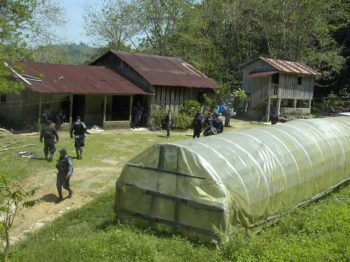Authorities in Honduras have destroyed more than 100 acres of coca crops this year, showing that criminal groups continue to use the country as a testing ground for cocaine production.
The latest seizure occurred on October 14, when the Honduran Directorate for the Fight Against Drug Trafficking (Dirección de Lucha Contra el Narcotráfico – DLCN) located and destroyed three acres planted with 4,000 coca bushes in Iriona, a municipality on the Caribbean coast in the department of Colón, according to a news release.
A week earlier, the National Anti-Drug Police Directorate (Dirección Nacional Policial Antidrogas – DNPA) raided two separate coca plantations with camps for processing cocaine, according to another news release.
SEE ALSO: US Alleges Honduras Drug Lab Operated with Presidential Protection
The seizures add to a growing number of raids on coca plantations this year. From January to November 2020, Honduran authorities dismantled 15 cocaine-processing camps and destroyed about 346,500 coca plants spread over 102 acres in the departments of Yoro, Olancho and Colón. The DNPA reports having discovered 10 laboratories and 331,500 coca plants, while the DLCN has registered 5 laboratories and at least 15,000 plants.
An anonymous intelligence official who spoke to El Heraldo about the seizures alleged that Mexican organized crime groups could be involved in facilitating cocaine production in Honduras by sending cash and personnel to establish coca fields and drug processing camps. The outlet noted that Colombians are also thought to have traveled to Honduras to provide cocaine-processing expertise.
InSight Crime Analysis
After years of low-level experimentation, coca cultivation in Honduras is seemingly expanding, with cocaine production coming online — potentially reducing costs and shortening supply chains.
Coca cultivation first began in Honduras around 2014, when authorities began finding coca plantations in Lempira, Yoro, Olancho and Colón, departments which make up a major part of a land trafficking corridor from the Caribbean department of Gracias a Dios to the Honduras-Guatemala border. Marijuana plantations had long been prevalent in the region, but the sudden appearance of coca caused authorities to look at the possibility of outside crime groups being involved, including those in Guatemala, Colombia, and Mexico.
While there is no real evidence of any Jalisco Cartel presence, the Sinaloa Cartel has long been suspected of partnering with Honduran traffickers. Honduran authorities’ emphasis on fingering outside cartels may serve to deflect attention from the participation of domestic criminal groups or even local officials.
Honduras has long been a transit point for cocaine trafficked by air and sea along its remote coastline, jungle, and mountain regions. The same “transportista” groups that receive, store and move US-bound drugs may also be experimenting with coca cultivation and cocaine production.
SEE ALSO: Honduras Profile and News
Indeed it was “Los Cachiros,” a local drug-trafficking group, that controlled the territory where the first Honduran cocaine labs were found. Since the capture and extradition of the group’s leaders to the United States in 2014 and 2015, significant evidence has emerged that high-level officials and politicians protected not only drug shipments but also production facilities.
Coca grown in Honduras, however, is of a lesser quality than that grown in South America. Honduran coca crops are often immature plants ranging from 15cm to 80cm, with the largest plants reaching 1- to 1.5 meters in height. Colombian plants measure up to 2 meters. The cocaine content of the Honduran-grown plants is likely to be lower than Andean-grown coca, given that potency is strongly connected with altitude.

